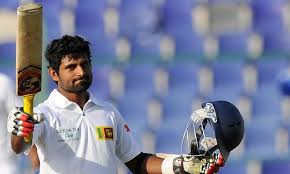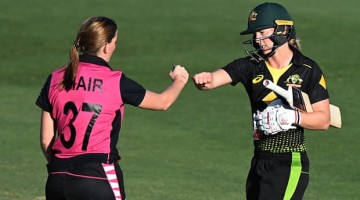
Brilliant Inning by Kausal Silva……
For the past three weeks, Kaushal Silva has been stuck in an unhappy singles party that threatened never to end. Four, 7, 5, 2 and 0 – those were his scores for this series. Remember that Silva is an opening batsman. For an opening batsman, such numbers are not good. They are not even good enough to be called “not bad”. In his final innings of the series, Silva again did not make a double-figure score. And Sri Lanka were thrilled.
The 115 that Silva compiled on the penultimate day of this campaign was as valuable as it was unexpected. Sri Lanka began the day one wicket down, still trailing by two runs. The morning session would be critical. Within ten overs, another wicket had fallen, the sharp-eyed Peter Nevill pouncing on Dimuth Karunaratne’s lifted foot like an Olympic walking judge. Nevill’s stumping was legal, if a little provocative, and Sri Lanka still had much work to do.
The trophy is theirs, but to complete a historic whitewash Sri Lanka had to set Australia a target that gave their bowlers a chance. When two more wickets fell before lunch, Australia were dreaming of a quick demolition of the lower order and a face-saving chase. And yet by stumps they had still not dismissed Sri Lanka, who were 312 for 8 – Dhananjaya de Silva was on 44 and Suranga Lakmal yet to score – and leading by 288.
Once upon a time, Australia scored more than that in the fourth innings of a Test in Asia. Emphasis on the once. The only time that has happened – win, lose or draw – was in 2006 in Fatullah, when they made 307 in a successful chase. But that was against Bangladesh, with an Australia team full of champions, and even then they made hard work of it, losing seven wickets along the way.
A more relevant comparison, perhaps, concerns their chances of batting out a draw. In the first Test of this series, Australia survived 88 overs in the fourth innings, failing to avoid defeat but at least proving that crease occupation can be achieved. If victory is out of reach on day five in Colombo, maybe Australia should all imagine themselves hamstrung, like Steve O’Keefe in that game. Forget running, just block it out.
Whatever the case, their victory chances were harmed mostly by Silva. Short in stature, little Silva produced an innings of platinum value to Sri Lanka. His defence was sound early, and he gradually became more expansive with his strokeplay. He was strong square of the wicket, punishing Australia’s spinners if they dropped short or gave him width. His work was all the more impressive given he had stitches in his hand after being injured while fielding earlier in the game.
Silva’s century came from his 251st delivery with a cover drive for four off the spin of Adam Voges, and the emotion was evident from the way Silva ripped off his helmet and roared in celebration. Another failure in this innings and his place in the side might have been in jeopardy. Instead, he registered the third hundred of his Test career, and his first for more than a year.
Eventually, just like in the women’s quadruple sculls last week, Jon Holland claimed Silva. On 115, Silva was lured forward by Holland’s flight, beaten by the dip and his edge was snapped up by Steven Smith at slip. His innings was over, but he had done enough. In any case, wickets had to fall or a declaration arrive from Angelo Mathews in order to make the final day interesting. After Silva fell, Rangana Herath was taken at slip off Lyon, leaving two wickets in hand.
Silva had received assistance throughout the innings from a series of team-mates who did what he has not all series – got out in double figures. Dinesh Chandimal reached 43 before he was lbw to Lyon from around the wicket, everyone on field seemingly surprised that Australia’s review was upheld, that Lyon’s delivery had pitched in line and straightened the required amount.
Lyon finished the day with four wickets. He made the only breakthrough of the middle session when Mathews, on 26, tried to sweep but succeeded only in top-edging a catch that lobbed up to Smith at slip. But the middle session was quiet by comparison with the first.
The most fascinating moment was Nevill’s stumping of Karunaratne. Lyon’s delivery turned past the edge and rested in the gloves of Nevill. That, you might expect, would be that. But Nevill was alert to Karunaratne’s tendency to lift his foot. He didn’t take his eyes off the batsman’s leg, and whipped the bails off at just the right time when Karunaratne momentarily lifted his foot off the ground.
The Laws of Cricket state that the ball is dead “when it is finally settled in the hands of the wicketkeeper or of the bowler”, but “whether the ball is finally settled or not is a matter for the umpire alone to decide”. Law 23 also states that “the ball shall be considered to be dead when it is clear to the bowler’s end umpire that the fielding side and both batsmen at the wicket have ceased to regard it as in play”.
If the batsman had regarded the ball as no longer in play, Nevill clearly had not, for he watched assiduously for Karunaratne’s movement. Like a motorist given a parking fine for staying one minute too long, Karunaratne was entitled to feel frustrated that a tiny lapse had cost him. But the lapse was his own, and if an eagle-eyed inspector had caught him out, Karunaratne had nobody to blame but himself.
Nevill even tried the ploy again in Lyon’s next over, but on this occasion Silva’s foot stayed grounded. It was a busy morning for the third umpire: Silva survived an Australian lbw review, and again on his own review when given out lbw, but there was no such positive outcome for Sri Lanka when Kusal Perera was given not out to an appeal for caught behind off Holland.
Perera was attempting a reverse sweep and the ball clearly sailed close to his top edge before bouncing off his body and lobbing up for Nevill to run forward and take. But with no Hot Spot or Snicko available to the TV umpire, Richard Kettleborough, could he overturn the decision? Kettleborough decided that a combination of audio and raw vision was enough – he felt the ball had hit the bat, and Perera was out.
The session ended with a more conventional dismissal, Kusal Mendis lbw to a fast, straight ball from Mitchell Starc that was not reviewed. At 98 for 4, Sri Lanka still had plenty to do. Fortunately for them, Silva was starting to look polished.
Categories: Cricket,Top Stories



